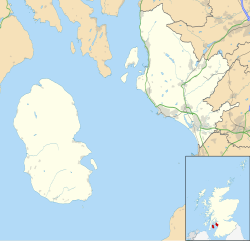Machrie
| |
|---|---|
 One of the standing stones on the moor | |
Location within North Ayrshire | |
| OS grid reference | NR891345 |
| Civil parish |
|
| Council area | |
| Lieutenancy area | |
| Country | Scotland |
| Sovereign state | United Kingdom |
| Post town | ISLE OF ARRAN |
| Postcode district | KA27 |
| Dialling code | 01770 |
| Police | Scotland |
| Fire | Scottish |
| Ambulance | Scottish |
| UK Parliament | |
| Scottish Parliament | |
Machrie (Scottish Gaelic : Am Machaire) is a village on the Isle of Arran in the Firth of Clyde, Scotland. Machrie Bay can be found on the West Coast. The village is within the parish of Kilmory. [1]
Contents
It is most well known for its Standing Stones that are a local tourist attraction, along with the King's Cave which was believed to have been used by Robert the Bruce.

